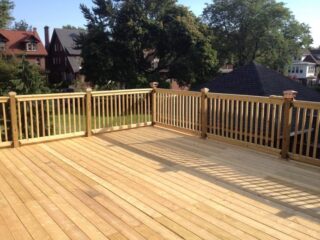
Few things are more satisfying as a homeowner than crossing a long-standing project off your to-do list — especially when it involves improving something you use every day, like outdoor stairs. For me, the stairs leading to my back doors were built last year and I can’t wait to get some color on them. I’ve chosen ZAR Solid Color Deck and Siding Stain for the job, white for the rails and risers and dark gray for the actual stairs and I’m excited to bring the wood to life with color and protection.
But lately, it’s been raining. And raining. And then raining some more.
If you’ve been stuck in the same soggy boat, you know the feeling: the first dry day hits, the sun finally makes an appearance, and every fiber of your DIY-loving being wants to race outside and get to work. But before you pull out the brush or roller, it’s crucial to pump the brakes and take a closer look at the conditions — not just above you, but around and underfoot.
Why Timing Matters More Than Motivation
Staining a deck — or, in my case, stairs — requires more than dry skies. It demands a balance of proper surface preparation, moisture levels, and the right temperature range. Ignoring these can lead to poor adhesion, peeling, uneven coverage, and, ultimately, redoing all your hard work.
So what does ZAR recommend?
Ideal Conditions for ZAR Solid Color Deck & Siding Stain
According to the manufacturer, the ideal air and surface temperature for applying ZAR Solid Color Deck and Siding Stain is between 50°F and 90°F (10°C – 32°C). Avoid applying the stain if rain is expected within 24 hours of application, easier said than done. Direct sun during application should also be avoided, as it can cause the stain to dry too quickly and lead to lap marks.
But beyond temperature, there’s another critical factor:
What About Wood Moisture?
Wood that’s too wet will not absorb stain properly, leading to blotchiness or premature coating failure. Ideally, the wood’s moisture content should be below 15% before staining. If it’s been raining for days, the wood has likely absorbed a significant amount of moisture — and just because the surface feels dry doesn’t mean it’s ready.
No Moisture Meter? No Problem (Sort Of)
While a moisture meter is the most reliable way to measure moisture content, not every homeowner has one lying around. Here are a couple of DIY tricks you can use:

1. The Foil Test
- Tape a piece of foil or plastic (like a painter’s drop cloth or a heavy-duty trash bag) about 12 inches square to the wood surface.
- Seal all the edges with tape.
- Leave it for about 4 – 6 hours in the sun.
- If you see condensation forming under the plastic, the wood is still too wet.
2. The Touch & Feel Test (Less Precise)
- Press the palm of your hand against the surface. If it feels cool and slightly damp, it’s probably not ready.
- Try scraping the surface with a dry knife blade. If it pulls up damp wood fibers, it’s too wet to stain.
Neither method is foolproof, but they’re better than guessing and hoping for the best.
The Takeaway
Yes, it’s hard to wait when the forecast finally clears up. But good staining is all about patience and preparation. The reward for waiting until the temperature, surface dryness, and moisture content are all within the ideal range is a durable, beautiful finish that will last for years.
So for now, I’m watching the forecast, doing the plastic test, and tapping my fingers on the deck railing like a kid waiting for recess. But when that window finally opens — and I know the wood is dry enough — I’ll be ready.



